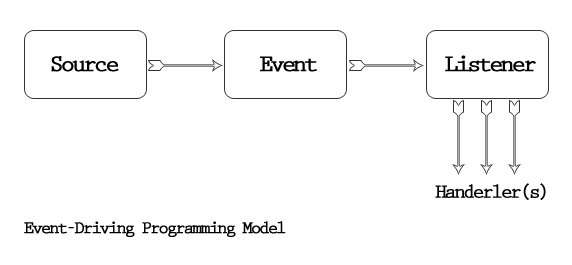引言
事件驱动模型与普通的编程模式的不同主要体现在数据的流向上,普通的编程模式是A调用B,B调用C,在此过程中一直是单项流向,而且C发挥着被调用的角色,事件驱动编程着力改变这一现状,C中去含有A,B,然后将自身传入到A,B中,然后在适当是时候在回调C的其他方法,在作者看来其实和上篇的文章的观察者模式么有什么差别,下面通过一个例子来说明
事件驱动编程在java中包含了3类对象:数据源,监听者,事件
为了更好的解释事件驱动模型的例子,文中借鉴了计算机大牛Lộc Nguyễn的代码,地址详见引用。
Example
Now, we are modeling a simple car object, which can fire a SpeedEvent. The listener is SpeedListener interface. Max speed is temporarily set to 60MPH, min speed 40, and the default 50 when the car starts driving on the highway.
如果没有事件对象这个传递者,其实这就是一个简化版的观察者模式的编程应用
|
|
Corresponding SpeedListener declares 2 handlers:
这不就是观察者模式中的那个观察者角色的抽象么。
|
|
Come back to the Car, it maintains a list of SpeedListeners:
这个Car作为事件源,是不是和我们之前的被观察者特别相似,区别在于这是一个没有进一步抽象,而是直接作用于监听者,例如下面的例子,当汽车加速时候去通知循环通知所有的listener,然后listener根据做出相应的hander事件,从观察者的模式看其实就是通知各个观察者,然后进行update操作
This processSpeedEvent(SpeedEvent e) method is to be executed when the SpeedEvent is fired. It calls each handler of each SpeedListener object in the speedListenerList, to notify and do something about that event.
|
|
That we has created and fired the event, and delegated to the listener to process the event. It’s up to the client code to implement the concrete handler(s).Here we have two handers with differnt implementation.
Hander one:
|
|
Hander two:
Write a test case:
Result output will be:
Alert! You have exceeded 40 MPH!
警告! 您已经超过 40 公里/小时
Alert! You have exceeded 90 MPH!
警告! 您已经超过 90 公里/小时
Uhm… you are driving 10 MPH. Speed up!
您现在的时速是 10 公里没小时. 请提速
总结
本文总结了java的事件驱动编程模型,抛去事件本身,其实就是一个观察者模型的应用,最后,源码地址:点击这里
声明
本文50%为翻译组合,50%为原创
引用
https://www.codeproject.com/articles/677591/defining-custom-source-event-listener-in-java
